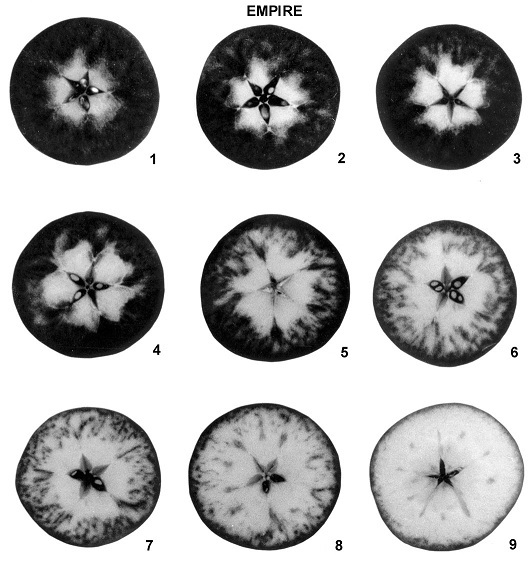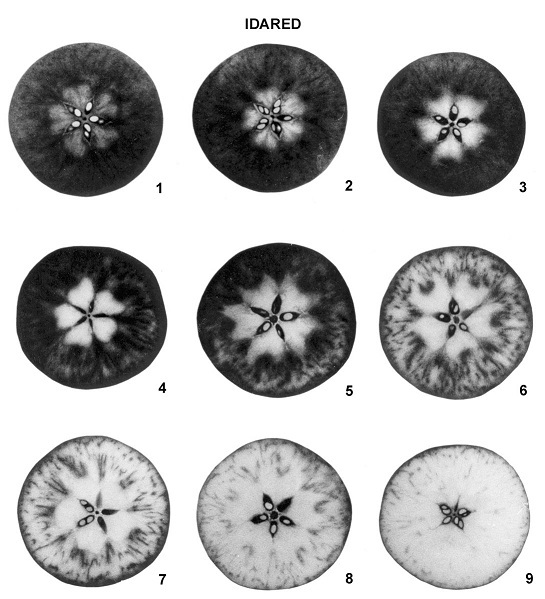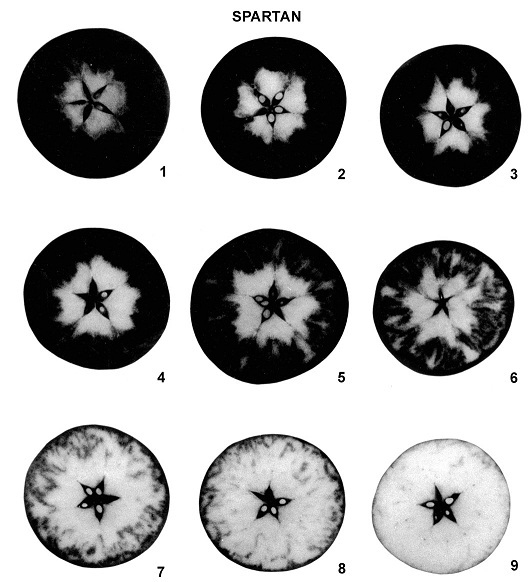Evaluating maturity of Empire, Idared and Spartan apples
Learn how the starch-iodine test which is one of several methods used to determine fruit maturity for Empire, Idared and Spartan apples.
ISSN 1198-712X, Published March 2000
Introduction
The starch-iodine test is one of several methods used to determine apple fruit maturity. The procedure for this test can be simply performed in the field.
Preparing the test solution
Always use a freshly prepared solution at the beginning of every season. This solution is sensitive to light and should be stored in a dark container. A dark-coloured bottle or a glass jar wrapped in aluminum foil will serve the purpose. Chemicals needed for this test are potassium iodide and iodine crystals. A pharmacist or a chemist can use the following recipe to make up the iodine solution.
Warning
Iodine is a very poisonous chemical. The iodine solution should be properly labeled and kept away from children and pets. Do not feed apples used in the test to any animals or used in composting. Do not allow pets to lick the fruit after testing. In case of ingestion of either iodine, or iodine treated apples, induce vomiting and consult a physician immediately.
Recipe
- Dissolve 8.8 grams of potassium iodide in approximately 30 mL of warm water. Gently stir the solution until potassium iodide is properly dissolved.
- Add 2.2 grams of iodine crystals. Shake the mixture until the crystals are thoroughly dissolved.
- Dilute this mixture with water to make 1.0 L of test solution. Mix them well.
Selecting apples for testing
It is very important to select representative samples for testing. Sample at least 3 trees of each cultivar in each orchard in order to give reliable results. Sample 10-20 apples from various parts of each apple tree.
Performing starch iodine test
In order to perform the test properly, the following requirements must be met:
- The iodine solution must be fresh and at a temperature higher than 10°C
- The 10–20 randomly collected apples should be tested immediately
- The fruit for testing should be at a temperature higher than 10°C. Either procedure A or B can be used depending on individual preference.
Procedure A
- Use a shallow glass pan. Pour some iodine solution into this pan to a depth of 5–8 mm.
- Cut each apple in half across the core. Soak the cut surface of the stem half in the iodine solution for one minute. The stem can serve as a convenient handle.
- Remove the stem halves from the test solution and place them cut surface up to drain.
- Score each fruit by comparison with the appropriate reference chart and calculate the average score for each lot of apples.
Procedure B
- Pour the iodine solution in a spray bottle equipped with a hand pump.
- Cut each apple in half across the core. Place them cut surface upward.
- Spray the iodine solution onto the cut surface. Wait for about 1 minute.
- Score each fruit according to procedure A-4.
Evaluating test results
Apples will show the starch-iodine test scores starting from 1 and ending at 9 over several weeks during the fall season. How to decide "What score indicates the proper harvest date for each grower's orchard?" depends mainly on when the apples will be marketed and what type of storage is used. Apples destined for long-term controlled atmosphere (CA) storage have to be picked early and therefore require a lower starch-iodine test score. Apples destined for immediate fresh market and processing plant can be picked later and therefore require a higher starch-iodine test score. The selection of the proper score largely depends on each individual operation. No single fixed score can be recommended to guide the whole industry.
In general, apples with starch-iodine test scores of 1, 2, and 3 are considered immature. Apples with scores of 4, 5, and 6 are considered mature. Apples with scores of 7, 8, and 9 are considered overmature. Normally, apples with a starch-iodine test score of 3 or 4 are good for long-term CA storage.


